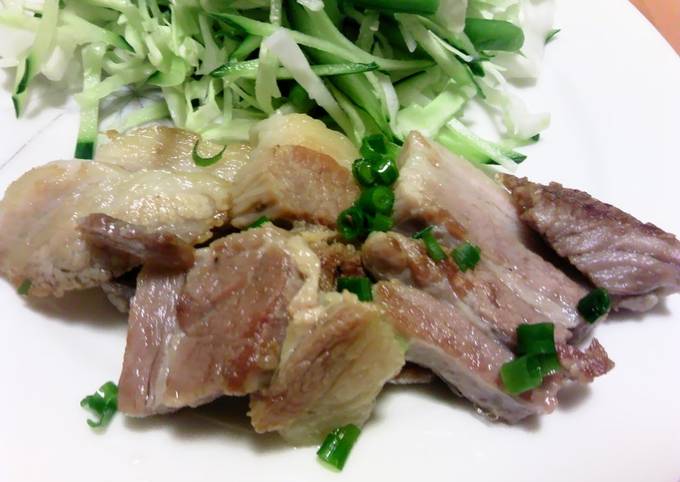
Hello everybody, it is me, Dave, welcome to our recipe site. Today, I will show you a way to make a distinctive dish, suuchikaa, okinawan salted pork. One of my favorites food recipes. This time, I am going to make it a bit tasty. This will be really delicious.
Huge selection of books in all genres. Free UK delivery on eligible orders. Low prices on millions of books. Free UK delivery on eligible orders Great recipe for Suuchikaa, Okinawan Salted Pork.
Suuchikaa, Okinawan Salted Pork is one of the most favored of current trending foods on earth. It’s easy, it is quick, it tastes yummy. It’s appreciated by millions daily. Suuchikaa, Okinawan Salted Pork is something which I have loved my whole life. They are nice and they look fantastic.
To begin with this particular recipe, we must first prepare a few components. You can cook suuchikaa, okinawan salted pork using 5 ingredients and 10 steps. Here is how you cook it.
The ingredients needed to make Suuchikaa, Okinawan Salted Pork:
- Prepare 200 ml Pork belly meat (block)
- Get 20 grams Salt (coarse sea salt if possible)
- Prepare 1 knob Ginger (unpeeled)
- Get 1 stalk's worth Japanese leek (the green part)
- Prepare 1 Green onions (finely sliced)
The key is to boil the pork in a lot of hot water in a large pot. The "suukachidon rice bowl I had once was so delicious that I asked the restaurant staff how it was made. They explaind that "salt is rubbed in to pork and it's left for a few days and then fried up until crispy." Based on that short answer I did. Rafute, slowly braised pork belly in a mixture of brown sugar, soy sauce and awamori until fork-tender; salted pork belly locally known as suchika; thin slices of pig's ear called mimiga; and tebichi, or simmered pig's feet, are some of the most widely enjoyed pork dishes in Okinawa.
Steps to make Suuchikaa, Okinawan Salted Pork:
- Use a block of pork belly. It's a bit different from the "three layer meat" (skin, fat, meat) they use in Okinawa, but it works well.
- Cover the meat with salt, and rub it in well. I wrote down an amount of salt for the recipe, but basically you should pack the meat completely in salt.
- Wrap the salted meat with newspaper. You can use paper towels too, but here we'll rely on the absorbent nature of newspaper.
- Put the wrapped meat in a ziplock bag, eliminate the air from the bag and seal it up. Let it rest in the refrigerator for about 4 days.
- Wash the pork well to remove the salt. Bring a pot of water with the green part of a leek and ginger to a boil, and put in the pork. Skim off any scum.
- When you have removed the scum, boil the pork for about 1 hour. Use a big pot with plenty or water, or the water will boil off while you're cooking the pork.
- Rinse the boiled pork again.
- Slice about 6-7mm thick (like the pork slices on ramen noodles). Pan fry with a little oil over high heat until crispy.
- Transfer to serving plates, sprinkle with some chopped green onion and enjoy!
- Here is what I served when I made this recipe. Red beans and rice (osekihan), suuchikaa with cabbage and cucumber, green bean salad, and egg plant and aburaage miso soup.
They explaind that "salt is rubbed in to pork and it's left for a few days and then fried up until crispy." Based on that short answer I did. Rafute, slowly braised pork belly in a mixture of brown sugar, soy sauce and awamori until fork-tender; salted pork belly locally known as suchika; thin slices of pig's ear called mimiga; and tebichi, or simmered pig's feet, are some of the most widely enjoyed pork dishes in Okinawa. Mirudaru – sliced pork marinated in black sesame paste, sugar and soy sauce, then steamed – is one of the. A traditional Okinawan dish in which chopped pork belly is slowly simmered with soy sauce or miso, brown sugar and awamori. The pork becomes tender and free of extra fat because of the long cooking time.
So that is going to wrap this up for this exceptional food suuchikaa, okinawan salted pork recipe. Thanks so much for your time. I am confident that you can make this at home. There is gonna be more interesting food in home recipes coming up. Remember to bookmark this page on your browser, and share it to your loved ones, friends and colleague. Thank you for reading. Go on get cooking!